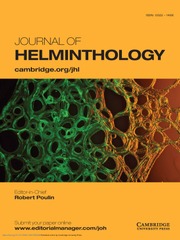Article contents
Positive associations between infections of Toxoplasma gondii and seropositivity with Anisakis simplex in human patients suffering from chronic urticaria
Published online by Cambridge University Press: 03 July 2014
Abstract
Toxoplasma gondii is a food-borne and orofecal microorganism which produces chronic infection, and attempts have been made to prove its negative association with atopy in the context of the hygiene hypothesis. Anisakis simplex is a fish parasite associated with chronic urticaria (CU) in endemic regions. We analysed the relationship between both infectious agents in CU. We included 42 patients with chronic urticaria (18 patients with CU associated with A. simplex sensitization and 24 not sensitized CU patients). Patients were assessed for atopy by a skin prick test (SPT) against common aeroallergens and for respiratory symptoms. Anisakis simplex sensitization was assessed by SPT and specific IgE by CAP fluoro-enzyme immunoassay (CAP-FEIA). Anti-T. gondii IgG levels were measured by enzyme-linked immunosorbent assay (ELISA). CU patients were analysed with respect to T. gondii seropositivity, A. simplex sensitization, atopy and immigrant status. The seroprevalence of T. gondii was 40.5% in CU patients and 42.1% in the control group. Immigrants were more frequently infected by T. gondii (41.2% versus 12%; P =0.036). Anti-T. gondii IgG antibodies were associated with past A. simplex parasitism (odds ratio 6.73; P =0.03) and independently with atopic sensitization (odds ratio 5.85; P =0.04). In CU patients, T. gondii has no protective effect on atopic sensitization or A. simplex sensitization.
- Type
- Research Papers
- Information
- Copyright
- Copyright © Cambridge University Press 2014
References
- 2
- Cited by


